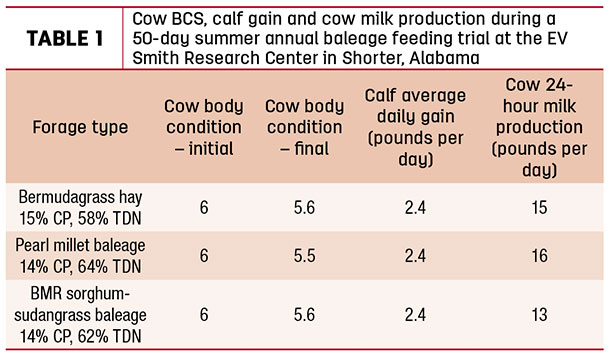Spring is often the time of year when we think about making high-quality baleage out of cool-season annuals in this region of the U.S., but what about the next growing season? Can I use my equipment to also harvest warm-season forage as baleage as well? The short answer is yes.
Although some research has been conducted with warm-season perennials for baleage production, there is little information available about the use of warm-season annual grasses as baleage, especially as part of a winter-feeding program for the cow herd.
The research
A recent feeding evaluation with cow-calf pairs at Auburn University highlighted animal performance and forage quality in a fall-calving cow herd using summer annual baleage during the winter-feeding period. Tifleaf 3 pearl millet and AGS6402 sorghum-sudangrass (a brown midrib [BMR] variety) were planted in early June 2016 and harvested three times during the study. Forage harvests generally followed a four-week regrowth interval during the growing season. Cows and calves were fed either pearl millet or sorghum-sudangrass baleage, or Tifton 85 bermudagrass hay during a 50-day feeding trial. Animal performance during the feeding trial is shown in the table below (Table 1).

All cows maintained a body condition score (BCS) of 5.5 to 6 during the feeding period, which coincided with peak lactation. The average milk production by each cow during a 24-hour period was 15 pounds, and was similar across forage diets. All calves had an average daily gain of 2.4 pounds per day. Forage total digestible nutrient (TDN) concentration was 58 percent for bermudagrass hay, 62 percent for BMR sorghum-sudangrass and 64 percent for pearl millet baleage, respectively. Crude protein ranged from 14 to 15 percent for all warm-season forages used in the trial, which illustrates the high quality of the forages evaluated in the study.
What does this mean?
This data indicates that summer annual baleage can serve as a high-quality alternative to dry hay to support animal production during the peak of the production cycle. Producers should always conduct a forage analysis to determine if additional supplemental feed is needed to support performance, monitor cow BCS after calving and make nutritional adjustments as needed to achieve animal performance targets.
Cost of production of summer annual baleage should be closely considered for a producer to profit from this management practice. Evaluate if there are potential savings in forage waste, labor and animal performance when deciding to incorporate baleage into the production system. ![]()

-
Kim Mullenix
- Assistant Professor/Extension Specialist
- Auburn University
- Email Kim Mullenix








